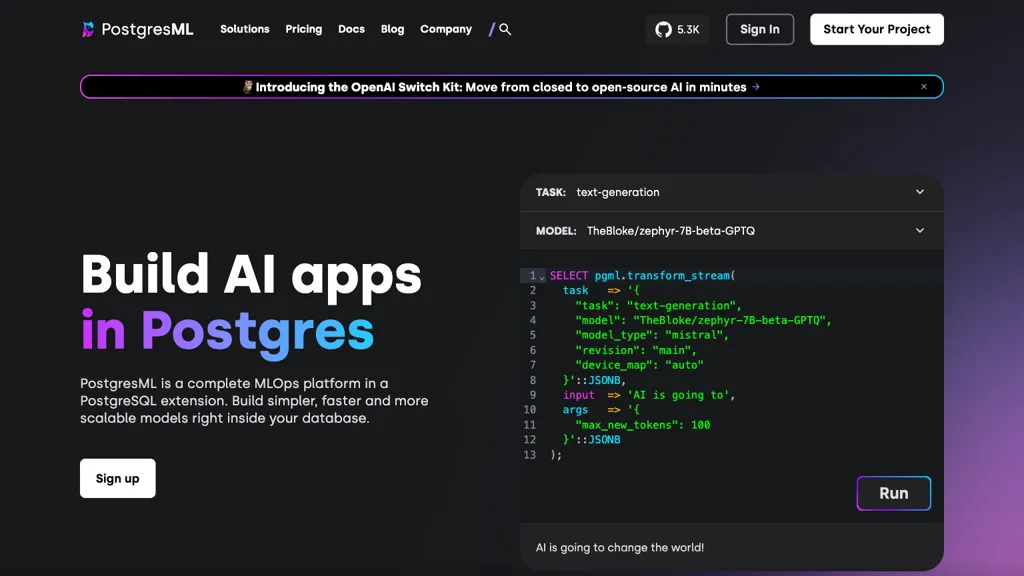What is PostgresML?
PostgresML is an advanced AI tool that’s designed to make machine learning work natively inside your PostgreSQL databases. It’s a full-cycle MLOps platform that simplifies all the building, training, and deploying of models. With PostgresML, users abstract themselves from typical data management complexity and speed up their ML/AI workflows. Currently, more than 50 algorithms are supported, and it is highly scalable, making it one of the most viable options for performing data analysis locally and on the cloud.
PostgresML Key Features & Benefits
PostgresML hosts a wide range of features that suit different user requirements, including the following:
- Support for easy integration with PostgreSQL databases.
- Create, train, and deploy ML models directly in the database.
- Support for various regression algorithms, including fraud detection and time series forecasting.
- Over 50 supported algorithms.
- Integration with famous libraries in machine learning.
Benefits brought about by the use of PostgresML are immense, including the following:
- Simplifying ML/AI Full Lifecycle management.
- Minimizing complexities in data management.
- Improved performance on both local and cloud environments; Effortless scaling as need grows; Empower SQL to create and deploy ML models.
Use Cases and Applications of PostgresML
Following are some contexts where the use of PostgresML can be seen:
-
Smart Toy Chatbots:
PostgresML will enable retailers to deploy chatbots into workflow automation where integration is smooth and model training in PostgreSQL databases is efficient. -
Site Search Management:
PostgresML can be used to optimize site search using NLP and ML models by abstracting the complexities of data management for seamless user experiences. -
Fraud Detection & Time Series Forecasting:
Support for more than 50 algorithms helps improve fraud detection systems and time series forecasting with better performance locally and on the cloud.
Using PostgresML
PostgresML use involves several simple steps, as will be shown below:
- Integrate the functionality of PostgresML into your existing PostgreSQL database.
- Select the appropriate algorithm for fraud detection, time series forecasting, or other applications.
- Training of your machine learning model using its integrated environment.
- The model that is trained can be pushed to the database directly for deployment. Real-time predictions and analytics become a breeze.
Best Practice
It is better to refresh and retrain your models periodically for their accuracy. Higher functionalities can also be achieved with extensive library support:
- Monitor performance and scalability of your models in local and cloud environments.
How PostgresML Works
PostgresML embeds machine learning models directly into PostgreSQL databases. That being said, it relies on various regression algorithms and allows the integration of popular ML libraries for a smooth workflow. A general flow on how one would work with PostgresML would include:
- Data ingestion and preprocessing within the PostgreSQL environment.
- Model selection and training using the integrated ML algorithms.
- Deployment of the trained model – allows for in-database predictions and analytics. This tight integration removes the requirement for a separate microservice and offers great performance gains.
Pros and Cons of PostgresML
Like any tool, PostgresML is no exception and has its pros and cons:
Pros:
- Tight Integration with PostgreSQL databases.
- Simplifies ML/AI lifecycle.
- More than 50 algorithms supported.
- Scaling is easy.
- Higher performance on-premises and in the cloud.
Cons:
- Might take time to learn for those developers who are new to SQL-based machine learning.
- Dependency on PostgreSQL, thus limiting the use of environments where PostgreSQL is a preferred choice for a database.
Conclusion about PostgresML
In other words, PostgresML is a very capable system that makes it simple for one to introduce machine learning right into PostgreSQL databases. It has all the features and a well-rounded workflow that make it appealing for data scientists, machine learning engineers, and database administrators. This capability to ease the ML lifecycle, combined with support for a wide array of algorithms, positions this solution to be of high value in both a local and cloud environment. In the future, more enhancements and updates are bound to increase its capacity and user audience.
PostgresML FAQs
What kind of algorithms does PostgresML support?
PostgresML supports over 50 algorithms, which include some regression techniques on fraud detection and time series forecasting.
Does PostgresML support cloud environments?
Yes, PostgresML is meant to perform excellently on both a local and cloud environment.
Who is PostgresML designed for?
Data scientists, machine learning engineers, and database administrators alike can leverage the extensive capabilities brought forth by seamless integration with PostgresML.
Does PostgresML require any learning curves?
There is, indeed, a learning curve, especially for users who might be new to performing SQL-based machine learning; however, it’s fairly smooth thanks to the integration and support of popular ML libraries.










